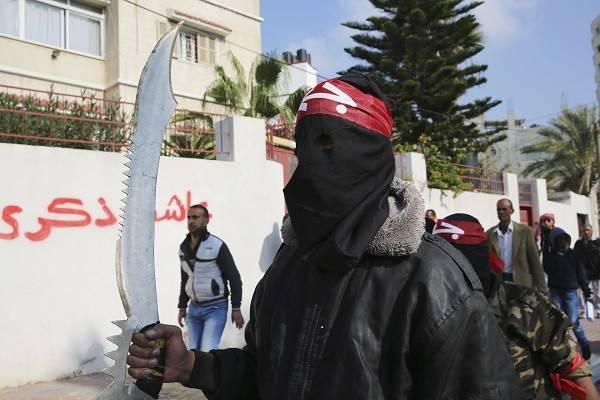What is the Palestinian Martyrs Fund? Is it a reward for terrorists — or a system of social welfare for those in genuine need?
By: Daniel Pomerantz/The Algemeiner
A Washington Post fact-checking analysis attempts to make the case that the fund is not primarily a reward for terrorism — but a misunderstood social welfare program, unfairly maligned by Israeli and American researchers:
“A big problem is definitional. Netanyahu refers to ‘terrorists and their families.’ In the Palestinian Authority’s budget, one can find $350 million in annual payments to Palestinian prisoners, ‘martyrs’ and injured, but can one with certainty say they are all terrorists?” wonders journalist Glenn Kessler.
As an aside, the Martyrs Fund has recently been increased to $403 million.
To this end, Kessler repeats Palestinian arguments that the fund is a kind of social welfare program, cherry picking examples that would appear to support this claim. He also criticizes rigorous Israeli and US research.
Finally, Kessler completely avoids examination of the one thing that would utterly topple his dubious case: Palestinian law itself.
Palestinian Law
Palestinian law requires seven percent of the PA’s annual budget be paid to the so called, “Martyrs Fund.” About this fact, there is no debate: it is the plain language of the existing law.
The Palestinian Budget Book (2017) specifically states that payments to killed or imprisoned Palestinians and their families from the Martyrs Fund are not social welfare but a salary — paid because the recipients constitute a “fighting sector.”
The salaries referenced above increase directly in proportion to the severity of the crime involved. For example, murder earns the perpetrator a higher salary than committing bodily injury, which earns a higher salary than possessing a weapon. Again, this not mere opinion or conjecture, this is the Palestinian law.
With no attempt to verify, Kessler repeats the following Palestinian claim: “[T]he PLO says martyr payments go not only to people who were killed or injured by Israeli forces but also to victims of other events, such as a fiery 2012 bus accident that killed seven children and a teacher.”
This, and other similar devices, are the fragile scaffolding upon which Kessler attempts to build his case that the Martyrs Fund is not actually designed around terror — all while ignoring what the law itself actually says, and how it actually works.
“One Man’s Terrorist…”
His article in the Post goes on to draw a disingenuous moral equivalence between modern Palestinian terrorism and the Irgun’s bombing of the King David Hotel in 1946, using the tired and long discredited refrain: “As the cliche goes, one man’s terrorist is another person’s freedom fighter.”
This phrase originated in the aftermath of 9/11, when Stephen Jukes, then Reuters’ head of global news, implemented an official policy of not using the word “terrorism,” saying in a leaked memo: “We’re trying to treat everyone on a level playing field.” Jukes caught a lot of flak for the news service’s terror-free policy.
Jukes later admitted that he had another, more cynical motivation for the memo: “[W]e don’t want to jeopardize the safety of our staff. Our people are on the front lines, in Gaza, the West Bank and Afghanistan.”
It seems that Jukes decided to forbid using the word terrorism because of his fear that he might offend terrorists. (Terrorists who might then target his staff with…you guessed it: acts of terror.)
This is not a matter of mere semantics: combating terrorism begins with defining it. Numerous scholars and media personalities criticized Jukes’ turn of phrase, explaining that its long-term impact makes it increasingly difficult to face, much less to combat, global terror.
In 2004, Reuters and Canada’s Canwest media chain even had a standoff over terror when editors unilaterally added the t-word to Reuters content.
King David Hotel Bombing
Kessler’s description of the bombing at the King David Hotel is highly misleading. The Jerusalem hotel was a headquarters of the British military command and the British Criminal Investigation Division (CID), making it a military target. Before targeting this military headquarters, the Irgun called ahead to warn of their plan, urging the hotel’s evacuation. I’m not aware of any Palestinian terrorist ever making such a warning.
Both in 1946 and still today, many Israelis have mixed feelings about whether the Irgun was right to act as it did. Yet right or wrong, there was a clear reason: the British military was arresting and preparing to deport Jewish refugees who had fled from Europe during and after the Holocaust. The world’s horror over precisely these type of deportations led to formation of the modern international law on refugees.
By contrast, the Martyrs Fund pays people who kill civilians in pizza parlors and coffee shops, and butcher entire families to death in their homes. Whether you call that “terror” or “freedom fighting,” it bears absolutely no comparison to the Irgun’s attack.
Palestinian Terror is Not ‘Very Fuzzy’ for Victims
Kessler concludes that it is “very fuzzy” whether the Palestinian government truly paid the exact figure of $350 million to terrorists and their families. Yet most of the word count is dedicated to the article’s real point: that Israeli and American studies on the topic are a essentially an attempt to malign the misunderstood Palestinian government.
The Martyrs Fund is, by the very Palestinian law that established it, designed around terror. The only thing that’s fuzzy is why this incontrovertible fact is so conspicuously absent from The Washington Post’s fact-checking.
